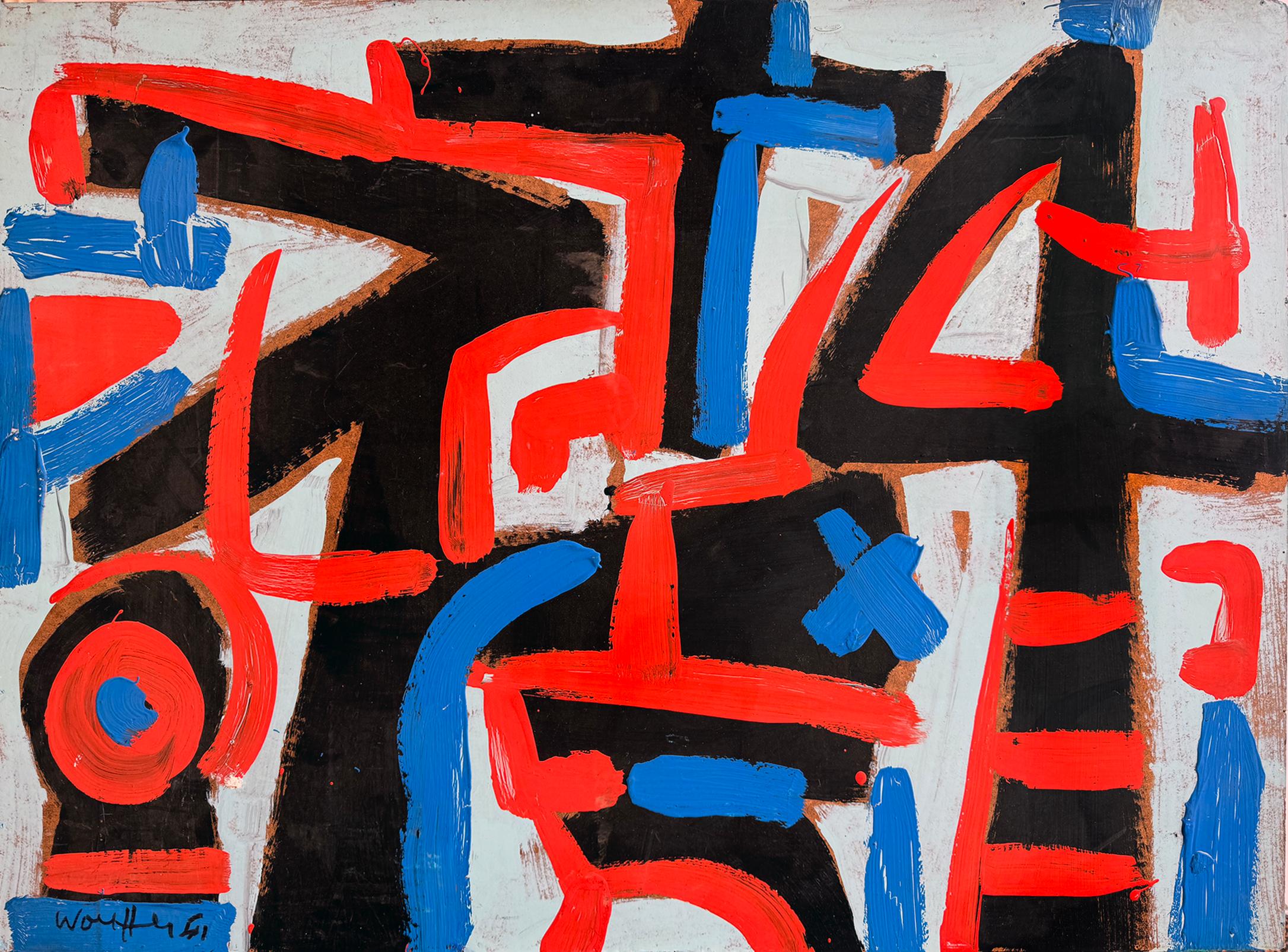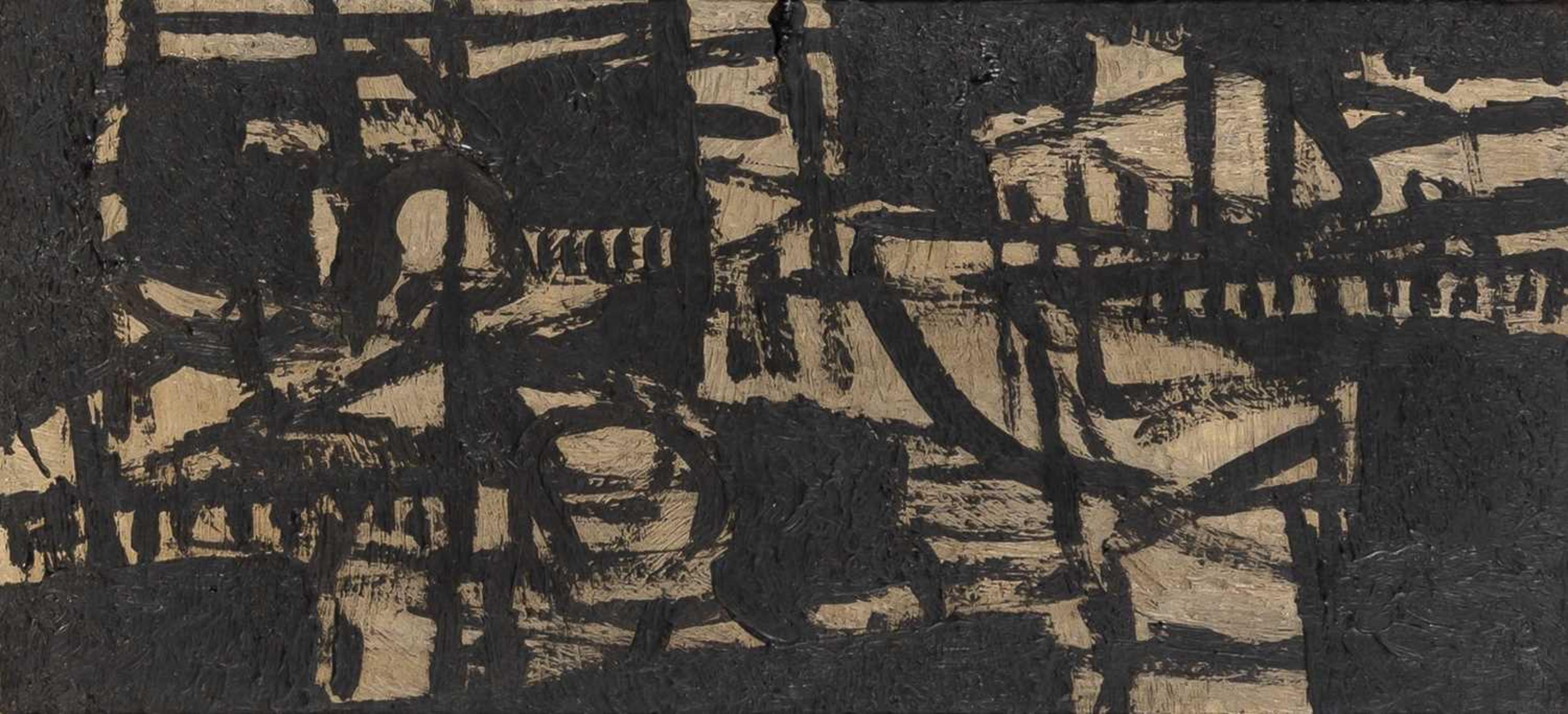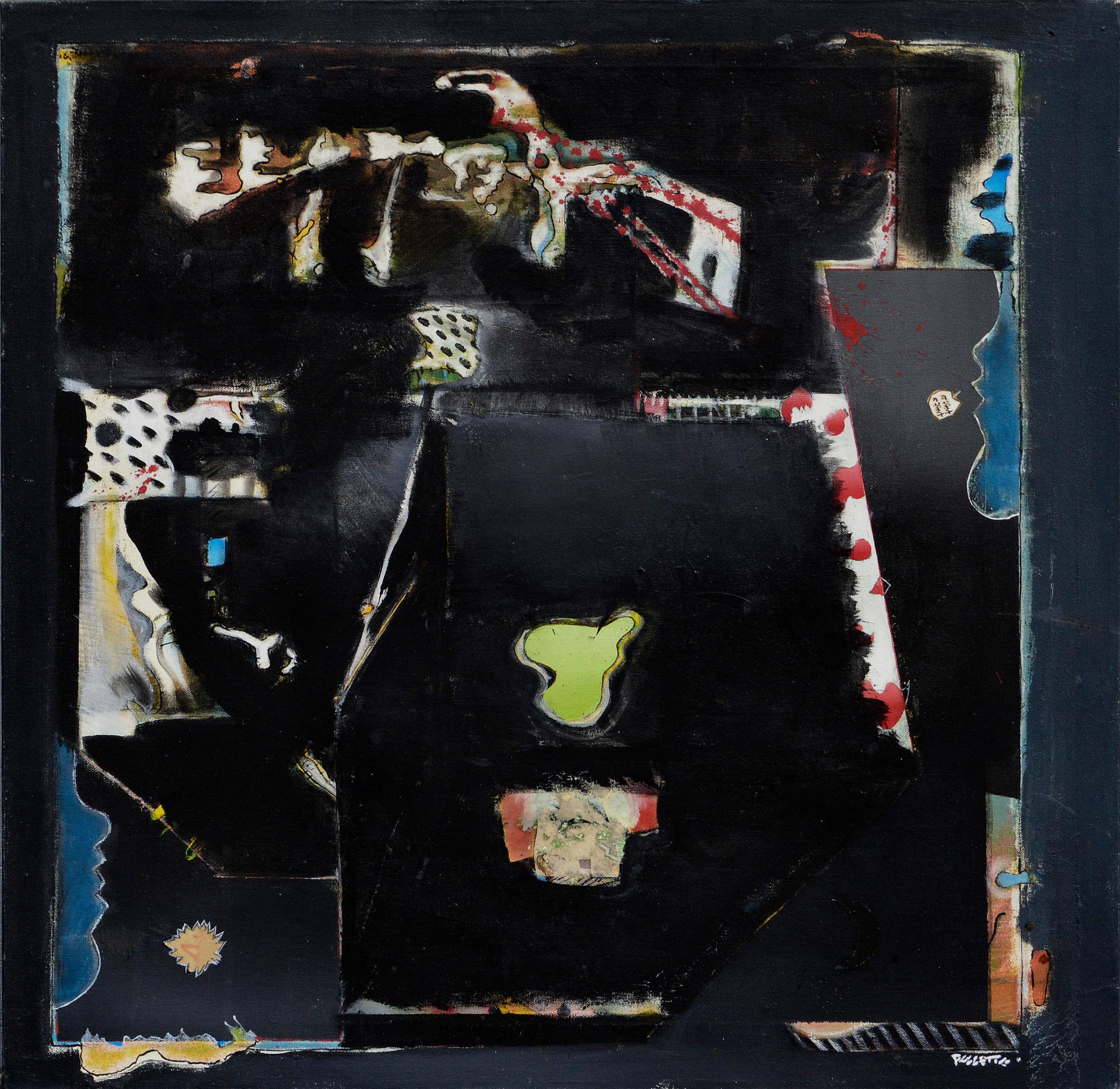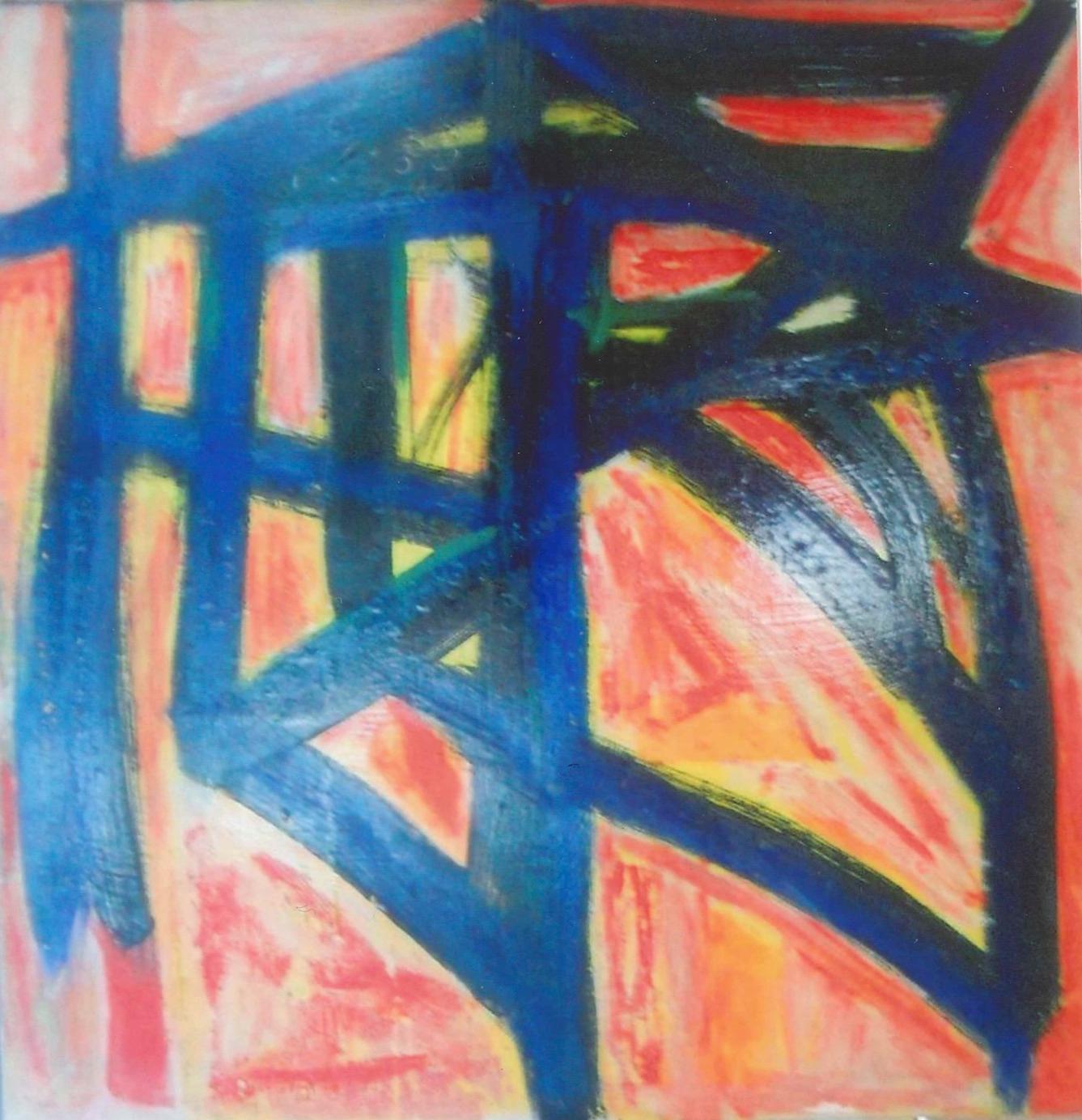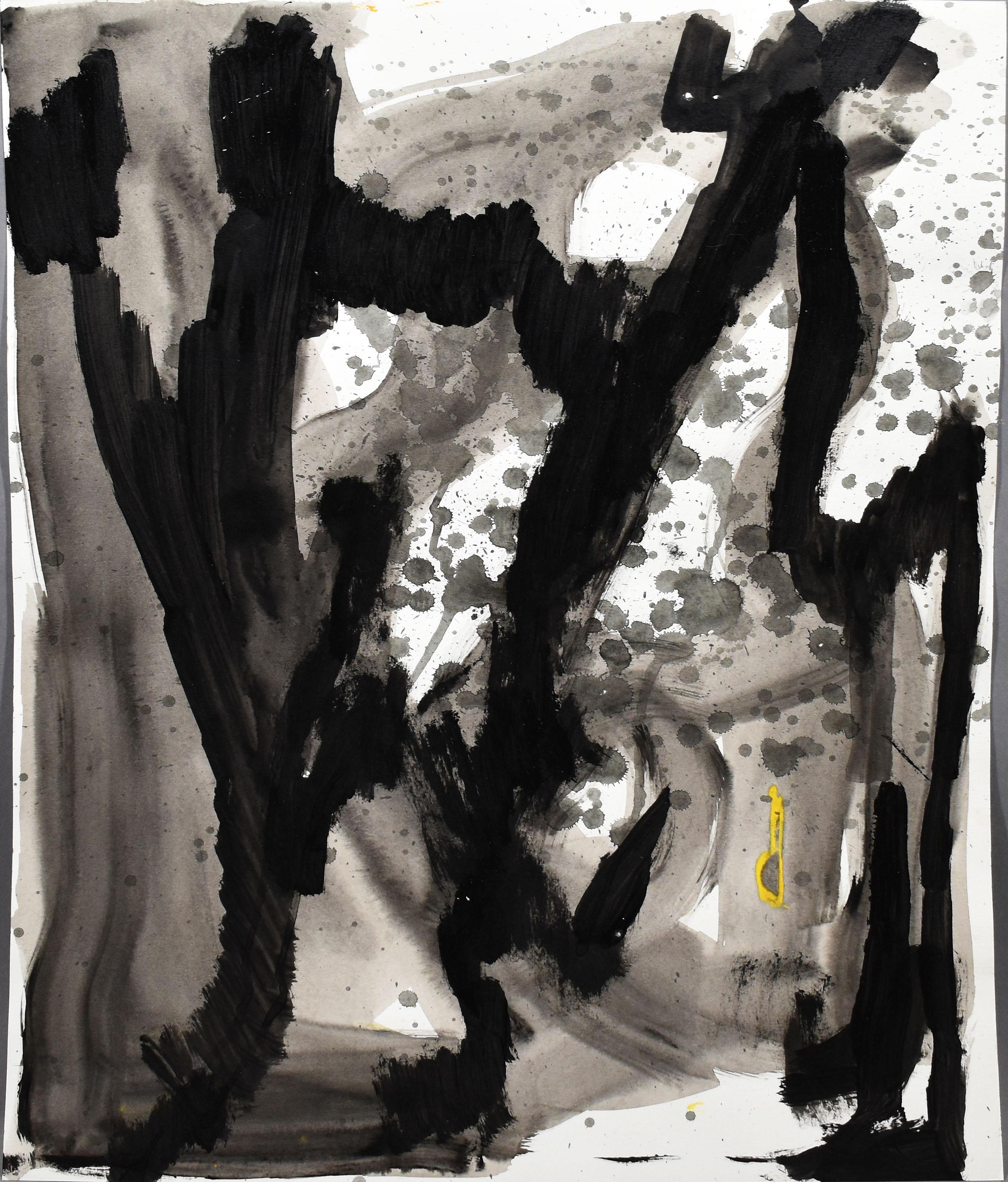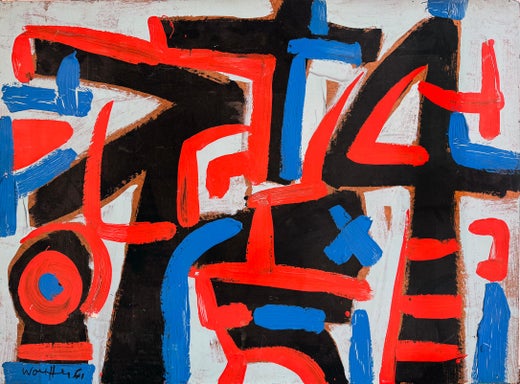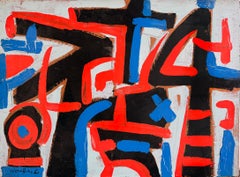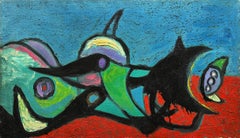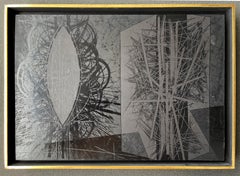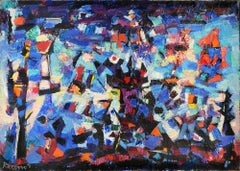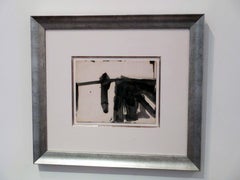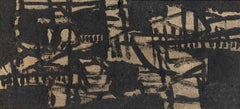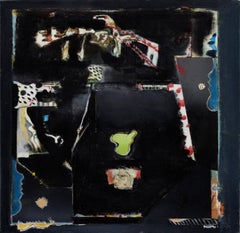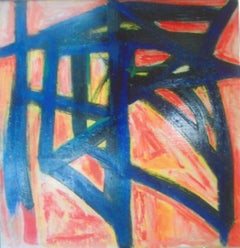Items Similar to Early Abstract Expressionist - Black Mountain College Teacher, Franz Kline
Want more images or videos?
Request additional images or videos from the seller
1 of 16
Emerson WoelfferEarly Abstract Expressionist - Black Mountain College Teacher, Franz Kline1951
1951
$38,000
£28,983.76
€33,005.50
CA$53,401.59
A$58,241.94
CHF 30,852.65
MX$698,238.14
NOK 392,925.62
SEK 359,301.32
DKK 246,583.37
About the Item
With Abstract Expressionist painting, one could argue that the earlier, the more historically important. This stunning non-objective action painting is characterized by vast swaths of pure color applied quickly and dynamically. One might think it was a Franz Kline in color. However, it was done by trailblazer Emerson Woelffer and was painted in 1951. The date says it all.
Signed and dated lower right. unframed
provenance: The Artists' Gallery, New York, Estate of the artist
The uploaded video on 1stDibs is coming up a bit off color. Refer to the still images for more accurate color
Emerson Seville Woelffer (July 27, 1914 – February 2, 2003), was an American artist and arts educator. He was known as a prominent abstract expressionist artist and painter and taught art at some of the most prestigious colleges and universities. Woelffer was one of the important people in bringing modernism to Los Angeles, when he taught at Chouinard Art Institute.
Woelffer was born July 27, 1914, in Chicago, Illinois.[2][3] He studied at the Art Institute of Chicago between 1935 and 1937, with László Moholy-Nagy.[2]
In 1938 he joined the WPA Arts Program.[2] After serving in the US Air Force, from 1942 until 1949, he taught at Art Institute of Chicago.[1] At the request of Buckminster Fuller, in 1949 he taught at Black Mountain College.[1] In 1954 he taught at the Colorado Springs Fine Arts Center.
In 1959 he and his wife Dina moved to Los Angeles, California, where they settled down in the Mount Washington neighborhood.[1] From 1959 to 1973 he taught at the Chouinard Art Institute (now known as California Institute of the Arts) in Valencia, California.[1]
From 1974 and 1992 he taught at The Otis Art Institute (now called Otis College of Art and Design) in Los Angeles, serving as Chair of the Painting Department from 1974 to 1978. In 1991 he received an Honorary Doctorate Degree from Otis College of Art and Design in Los Angeles. He felt such a strong attachment to Otis that he left his estate to the college in the form of an endowment, to set up a scholarship fund to benefit future artists.[1][4]
Woelffer is best known for his boldly colored abstract paintings and collages with jagged forms. He also created sculpture and lithographs. Late in his career―suffering from macular degeneration―he began working in white crayon on black paper.
Woelffer's work is held in many public museum collections including at Colorado Springs Fine Arts Center, Honolulu Museum of Art, the Montana Historical Society (Helena, Montana), Museum of Art (Brigham Young University, Provo, Utah), Museum of Contemporary Art San Diego, Neuberger Museum of Art, Oklahoma City Museum of Art, Portland Art Museum,[5] San Diego Museum of Art, Yellowstone Art Museum (Billings, Montana),[6] Asheville Art Museum, Black Mountain College Museum + Art Center,[7] and San Francisco Museum of Modern Art (SFMoMA).
- Creator:Emerson Woelffer (1914 - 2003, American)
- Creation Year:1951
- Dimensions:Height: 21.75 in (55.25 cm)Width: 35.88 in (91.14 cm)
- Medium:
- Movement & Style:
- Period:
- Condition:Overall good conditions. A few minor scuffs visible mostly on close inspection. Nail holes on perimeter. Slight desaturation of color. Other than that, it presents very well for a work almost 75 years old - unframed.
- Gallery Location:Miami, FL
- Reference Number:1stDibs: LU385316211992
Emerson Woelffer
Once dubbed “the Grandfather of L.A. Modernism,” the Chicago-born Emerson Seville Woelffer was active as an innovative painter, collagist, and educator throughout his long and prolific career. A pioneering Abstract Expressionist, Woelffer’s brightly colored work with jagged forms reveals Cubist and Surrealist influences. Coming of age in Chicago during the Great Depression, Woelffer appreciated the improvisational nature of jazz music, a sensibility he would later apply to painting through gestural variation, energetic strokes, and a rhythmic use of line. From 1935 to 1938, Woelffer, a high school dropout, studied at the Art Institute of Chicago while employed as a janitor, early evidence of his enduring work ethic. He joined the Works Progress Administration arts program in 1938 as an easel painter, followed by a two-year stint as a topographical draftsman for the United States Air Force. The director of the Chicago Institute of Design, László Moholy-Nagy, invited Woelffer to join the faculty in 1942. His experiences there brought him into contact with the modernist idiom of the day, and his interactions with students caused him to re-examine his own practice. He also exhibited in group shows at the Guggenheim Museum in New York, participated in the Whitney Museum Annual (1949) and won the Pauline Palmer Prize for painting at the Art Institute of Chicago (1948). In 1949 Emerson Woelffer and his wife Dina, a fine art photographer, were invited by Jackson Pollock and Lee Krasner to New York before they headed to Mexico’s Yucatán Peninsula. Exposure to Pre-Columbian art led Woelffer to incorporate totemic figures and vibrant colors into his abstract paintings. In 1959 Woelffer joined the faculty at the Chouinard Art Institute (later the California Institute of the Arts) in Los Angeles, where he instructed notable emerging artists until 1973 and where he was instrumental in bringing Modernism to LA. Ed Ruscha was one of his students. In 1974, Woelffer was named chair of the art department at the Otis Art Institute (now the Otis School of Art and Design). His tenure lasted until his retirement in 1989, and he was widely admired for his interdisciplinary approach in the classroom. An endowed scholarship fund in his name provides support for promising young artists and designers. Suffering from macular degeneration, Woelffer switched to drawing with white crayon on black paper in his final years of artistic activity. Emerson won a prestigious Guggenheim Foundation Fellowship in 1967 and then went to wprk in Europe. Woelffer’s work is represented in the collections of such distinguished institutions as the Smithsonian American Art Museum, the National Gallery of Art, and the Museum of Modern Art, among others.
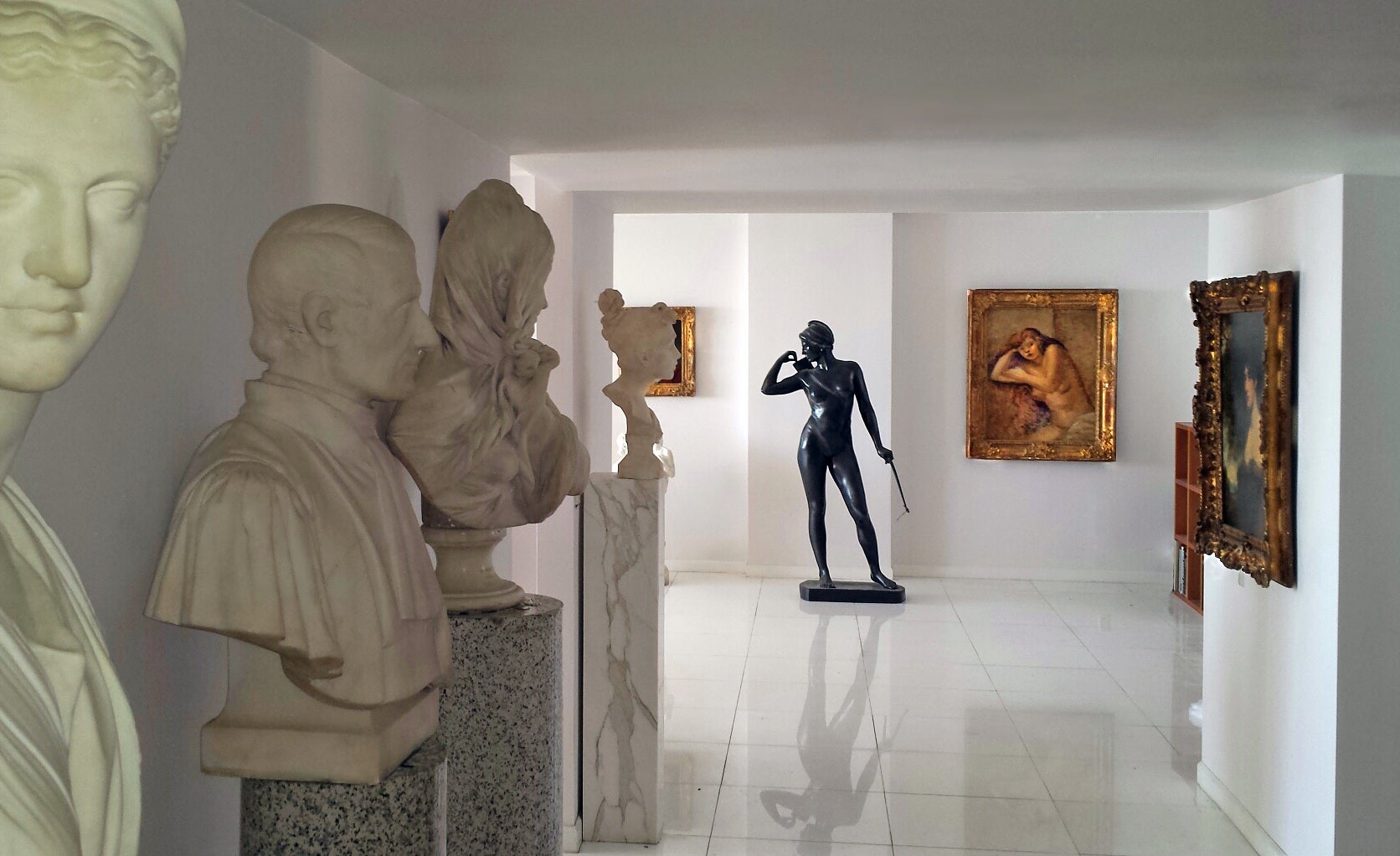
About the Seller
5.0
Vetted Professional Seller
Every seller passes strict standards for authenticity and reliability
Established in 2005
1stDibs seller since 2016
120 sales on 1stDibs
Typical response time: 1 hour
- ShippingRetrieving quote...Shipping from: Miami, FL
- Return Policy
More From This Seller
View AllAbstract Expressionist "Forms Divide" Like Franz Kline
By Emerson Woelffer
Located in Miami, FL
It's 1951. Who was doing painting like this? Franz Kline, Arshile Gorky, Jackson Pollock, Mark Rothko, Willem de Kooning, Adolph Gottlieb, Clyfford Still, Robert Motherwell, Lee Kra...
Category
1950s Abstract Expressionist Abstract Paintings
Materials
Masonite, Acrylic
Biomorphic Forms - Early Abstract Expressionist - like Arshile Gorky
By Emerson Woelffer
Located in Miami, FL
It's 1945. What artists were making totally abstract, non-objective paintings like this? Work characterized by organic forms and flattened picture planes, with solid bold colors dr...
Category
1940s Abstract Expressionist Abstract Paintings
Materials
Canvas, Found Objects, Oil
Black on Black #4
By Jimmy Ernst
Located in Miami, FL
The artist has painted the work in matte black and gloss black. It a sense this is also an optical art “Op Art” in that it changes as the light changes. Jimmy Ernst was a major figure of the New York School of abstract painting and part of The Irascibles, and son of Max Ernst:
Provenance: Grace Borgenicht Gallery, New York, New York; Joseph H. Hirshhorn, New York and Washington, D.C. (acquired from the above in 1966); Joseph H. Hirshhorn bequest, Hirshhorn Museum, Washington, D.C., 1981; Sotheby's Arcade, New York, New York, February 24, 1995, lot 331; The Jeanne and Carroll Berry...
Category
1960s Abstract Expressionist Abstract Paintings
Materials
Enamel
Storm Composition #3
By Abraham Rattner
Located in Miami, FL
An early example of Abstract Expressionism executed in 1955 during the movement's heyday and it's period of peak inventiveness. However, this work is still rooted in representation. The dark area the runs along the base of the picture is the ground and to the left, right and center there are black structures that represent trees. The work is very tactile and is composed of globs of paint that grow out from the surface and form a thick impasto. Rich vibrant saturated blues, reds and oranges create optical drama. The work look better in person. frame: 29 x 39 1/2 inches , Provenance: Kennedy Galleries
The Currier Gallery of Art...
Category
1950s Abstract Expressionist Abstract Paintings
Materials
Oil
Landscape Abstraction - Mid-Century - Twenty Paintings in One
Located in Miami, FL
When it comes to abstract painting, the creation date is important. At the height of Abstraction Expressionism, overlooked Academic Artist John Atherton created a wonderfully complex painting that embodies many of the characteristics of what was going on in Mid-Century American Art. The work is simultaneously abstract as it is representational. Like a Bento Box, it's divided into sections by dividers. On close inspection, each section stands on it's own as a beautiful mini-painting yet coalesces as part of the whole. From a distance, it is eye-pleasing, but as the view gets closer and closer, new structures and details gloriously reveal themselves. This is an important painting and not unlike the work of Joaquín Torres-García. It was done in the last year of the artist's life. Signed lower right. Canvas is relined. Framed size: 30 x 41.25. The work is best viewed with top gallery lights to bring out color.
Color will look different under different lighting conditions. Atherton exhibited at the famous Julien Levy Gallery in New York and his fine art is mainly associated with Magic Realism. He participated in the seminal 1943 Museum of Modern Art exhibition, American Realists and Magic Realists. The Museum of Modern Art has 4 Atherton paintings in its collection. As an Illustrator, Atherton did covers for the Saturday Evening Post, Fortune and Holiday Magazine...
Category
1950s Abstract Expressionist Abstract Paintings
Materials
Canvas, Oil
City Scape Abstract Expressionist Composition -Jackson Pollack Friend
By Joseph Meert
Located in Miami, FL
The fame, notoriety, and monetary value of an artist's work in today's market are not based on one's talent and vision. Factors such as marketing and media momentum play a defining r...
Category
1940s Abstract Expressionist Abstract Paintings
Materials
Gouache, Board
You May Also Like
Untitled
By Franz Kline
Located in Beverly Hills, CA
Provenance:
Marlborough Gallery
David McKee, Inc.
Manny Silverman Gallery
Private collection, Los Angeles
Category
1950s Abstract Expressionist Abstract Drawings and Watercolors
Materials
Paper, Ink
$104,000 Sale Price
20% Off
"Untitled" Roy Newell, Mid-Century, Black Abstract Expressionist Composition
Located in New York, NY
Roy Newell
Untitled, 1953
Signed and dated Roy Newell-1953
Oil on board
3 1/4 x 7 1/4 inches
Provenance
The Collection of Dr. and Mrs. Maximilian Le Witter
Estate of the above
Roy...
Category
1950s Abstract Expressionist Abstract Paintings
Materials
Oil, Board
Abstract Expressionist Composition on Black
By Ross H. Pollette
Located in Soquel, CA
Colorful and dynamic abstract composition by Ross H. Pollette, who also paints under the pseudonyms 'Max West' (American, b. 1948). Pollette has used oil, in...
Category
1980s Abstract Expressionist Abstract Paintings
Materials
Canvas, Ink, Mixed Media, Oil
$920 Sale Price
20% Off
Homage to Franz Kline - Oil Painting 2010 by Giorgio Lo Fermo
By Giorgio Lo Fermo
Located in Roma, IT
Homage To Franz Kline is an original artwork realized by Giorgio Lo Fermo in 2010.
Oil on canvas.
This contemporary artwork represents a colored abstract composition: the apparentl...
Category
2010s Abstract Abstract Paintings
Materials
Oil
American School New York City Abstract Expressionist Original MCM Oil Painting
By Barry Johnson
Located in Buffalo, NY
American school abstract painting. Watercolor on paper, circa 1960. Signed. Image size, 18"L x 24"H.
Category
1980s Abstract Expressionist Abstract Paintings
Materials
Canvas, Watercolor, Gouache
Mid Century Abstract Expressionist Painting
By Leslie Luverne Anderson
Located in Soquel, CA
Colorful abstract expressionist piece by Les (Leslie Luverne) Anderson (American, 1928-2009) that lends itself to either vertical or horizontal orientat...
Category
1960s Post-War Abstract Paintings
Materials
Masonite, Oil
